On October 20, 2014, the Smithsonian officially launched a National Capital Campaign, the first of its kind in the Institution's history. However, this is not the Smithsonian's first attempt at a national fundraising effort.
In 1925, the Institution's fourth Secretary, Charles Doolittle Walcott, started developing a strategic plan that included a capital campaign to supplement federal funds allocated to the Smithsonian. In the early stages of the campaign, before the actual launch was to occur in 1927, Walcott began soliciting contributions from the general public and prospective large donors, including members of the Smithsonian's Board of Regents.
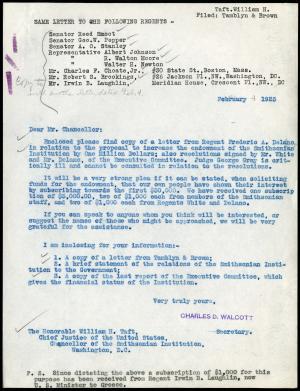
The campaign goal was to raise one million dollars, with the hopes of raising the first $50,000 from within (Regents and associates of Board members). Not all were capable, or perhaps willing, to contribute a suggested amount of $1,000. The Board's Chancellor, William Howard Taft, offered $250.
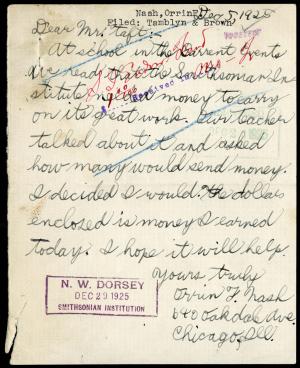
The first money to arrive for the Capital Campaign, though, came from an unlikely source. On December 5, 1925, Taft received the following letter:
Dear Mr. Taft:
At school in the current events we read that the Smithsonian Institute [sic] needed money. Our teacher talked about it and asked how many would send money. I decided I would. The dollar enclosed is money I earned today. I hope it will help. Yours truly, Orrin F. Nash
Taft forwarded the money to Walcott with the tongue-in-cheek missive, "My Dear Dr. Walcott: Here is the foundation for your $10,000,000. It is only one dollar, but I hope that it will prove to be a good beginning."
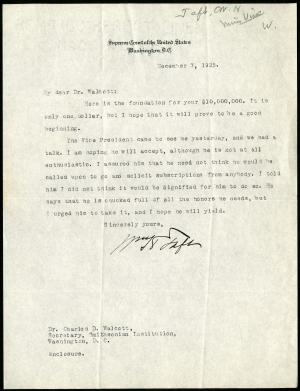
Walcott replied to Master Nash with a very sweet note of thanks.
It was most generous of you to make this contribution, which was the first received in response to the public announcement of the Institution’s need for additional funds. It is particularly appreciated because, having been a boy myself, I know how many alluring things they always have in mind on which to spend their dollars, and I do not believe that many boys would have been unselfish enough to send it for such a purpose. I hope the consciousness that you have made this sacrifice of some pleasure of your own for the benefit of others will more than repay you, for no one can tell what part your dollar may play in the ferreting out of some secret of Nature, and thus add its share to the sum of human knowledge for the enlightenment of other boys and girls and men and women for generations to come.
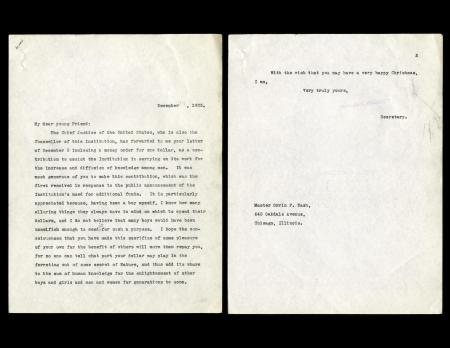
What became of Walcott's campaign? Well, it did not end as sweetly as it's one dollar beginning. On February 11, 1927, Walcott planned a "Conference on the Future of the Smithsonian" to kick off the campaign with scientists, politicians and prominent prospective donors in attendance. Unfortunately, two days before the conference, Walcott died. His successor, Charles Greeley Abbot, hosted the conference in his stead, but timing was not on the side of the campaign. Just as Abbot was completing the strategic plan and preparing to launch the capital campaign, the stock market crashed in 1929.
Related Resources
- Contribute to today's Smithsonian Campaign!
- Orrin F. Nash, Urbana Daily Courier, December 30, 1925, Illinois Digital Newspaper Collections, University Library, University of Illinois at Urbana-Champaign.
- Press Release announcing Smithsonian's 2014-2017 National Capital Campaign, Chronology of Smithsonian History, Smithsonian Institution Archives
- Secretary Charles Doolittle Walcott, Smithsonian Institution Archives
Related Collections
- Record Unit 45 - Office of the Secretary, Records, 1890-1929, Smithsonian Institution Archives
Produced by the Smithsonian Institution Archives. For copyright questions, please see the Terms of Use.

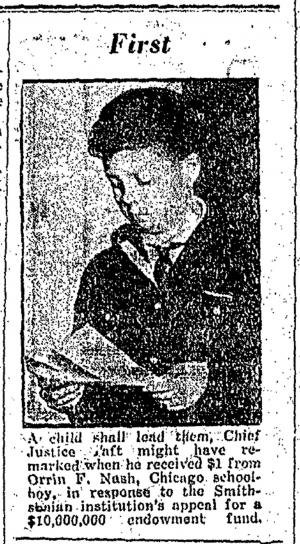
Leave a Comment